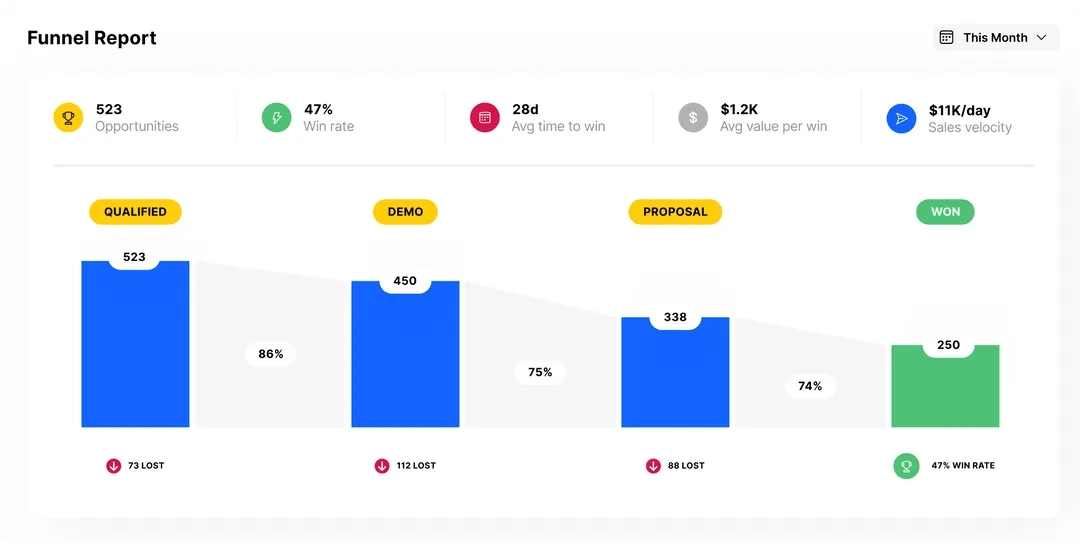At Close, we know how to sell SaaS.
We began as Elastic, Inc., an outsourced sales solution for Silicon Valley startups. After we developed Close for internal use, we pivoted and began to sell our inside sales software to SaaS sales teams.
We’ve worked with thousands of startups and seen countless successes and failures. We know what works, and we know what doesn’t. In our experience, these are the nine cornerstones of SaaS sales success.
1. Keep Your Trials Short
A long trial might seem like a good way to hook your customer, but you’re really just hurting your startup. For 99 percent of startups, trials shouldn’t be any longer than 14 days. Here’s why.
- Most people don’t use free trials for the full duration. Look at your metrics; you’ll see that most trial users duck out after about three days.
- Users take a short trial more seriously. Your prospects will procrastinate, and when they procrastinate, they forget. A shorter trial period makes them more likely to try your product immediately.
- Lower customer acquisition costs. Shortening your trial also shortens your sales cycle. For example, reducing your sales cycle from six weeks to three will significantly reduce customer acquisition and lead generation costs.
If your conversion rate remains low after shortening your trial, try these three strategies to convert lost trial leads into activation.

2. Optimize Your Email Campaigns
Unless you have a killer email campaign, most prospects will forget you exist within hours of enrolling in your trial. Here are three sales strategies to get the most out of your drip email campaign.
- Use “human” email addresses. Don’t ever send an email from a department. Instead of “Sales@YourBusiness.com,” use “YourName@YourBusiness.com.”
- Send a lot of emails. Your prospects are busy, so don't expect one or two emails to do the trick. Instead, schedule a drip campaign of at least five emails to get results.
- Send activity-based emails. Your sales email campaign should automatically email your leads for several weeks based on specific actions. For example, if they visit your pricing page, you might want to be a bit more sales.
Our sales CRM, Close, integrates with several powerful sales tools that make your drip campaigns much easier to manage. Check it out yourself with our 14-day free trial.
3. Call Your Trial Signups Immediately
Most fledgling SaaS businesses don’t call their trial users and those that do often wait until the last day. They don’t know how to sell SaaS.
The art of prospecting for SaaS requires a strategic approach that many have yet to grasp.
In the early stages of a startup, aim to call every trial user within five minutes of signup. Add this step to your sales process, and you'll:
- Drastically improve your reach rate. There’s a good chance the prospect is still at their computer with your product fresh on their mind. The longer you wait, the less likely your prospect is to answer.
- Quickly qualify or disqualify prospects. You need to make sure that your solution is a good fit for your prospect’s needs before you offer to close the deal. You can use the call to help them explore other options if it isn't.
- Handle objections effectively. A controlled phone call is the best environment to manage objections successfully. If they don’t have any, you can use this time to resolve common objections preemptively.
The business that understands the customer owns the customer. Pick up the phone and get to know your trial users, or they’ll never become your customers. This way, you will later achieve excellent customer support and SaaS onboarding processes while making more revenue.
if (window.convertflow == undefined) {
var script = document.createElement('script');
script.async = true;
script.src = "https://js.convertflow.co/production/websites/10698.js";
document.body.appendChild(script);
};
#cta_62308 .cf-form-2.cf-form-theme-default.cf-form-vertical.cf-field-regular button {
height: 40px !important;
}
#cta_62308 .cf-background-size-cover {
background-size: cover !important;
border-radius: 6px !important;
}
#cta_62308 {
margin: 3rem 0rem 3rem 0rem !important;
}
.post__content p:first-of-type {
margin-bottom: 0rem !important;
}
#cta_62308 .cf-form-2.cf-form-theme-default .cf-consent-label {
color: #28324E;
margin-bottom: 1rem;
}
#cta_62308 .cf-form-2.cf-form-theme-default .cf-consent-label {
line-height: 16px !important;
}
4. Give Short, Value-Focused Demos
The most common mistake I see startups make when giving demos is treating the demo like a training session. Your lead doesn’t need (or even want) to see every little thing your product does.
They want to know how it will help them be more successful. Here are three strategies to give product demos that sell.
- Qualify first. Don’t use demos as a qualification tool. Always qualify your leads before you give them a demo.
- Keep it short. 30–60 minutes is way too long. If you can’t explain how your product helps your prospect within 15 minutes, you don’t know your product or your prospect. Our demo is just 10 minutes long and still covers all the benefits.
- Focus on benefits, not features. Your prospects don’t care about every little button on your interface. Don’t tell them what your product does; tell them what it does for them.
A successful product demo is a demonstration of value, not a training seminar. Treat it that way, and you’ll be much more effective.

5. Follow Up Relentlessly
You will rarely close a deal on the first call. Startup sales success is dependent on your ability to follow up repeatedly. How often?
If your prospect has ever expressed interest in your product, follow up forever. Don’t settle for silence or “maybe;” maybes kill your startup. Keep calling and emailing until you get a clear “yes” or “no.”
If the lead is completely cold, follow this 14-day plan:
- Day 1: Initial contact.
- Day 3: First follow-up. Reach out at a different time of day with a condensed version of your initial message.
- Day 7: Second follow-up. Reach out at a different time of day and restate your call to action.
- Day 14: Third follow-up. If you haven’t received any response from your lead, send the break-up email. This is where response rates skyrocket.
If you don’t receive a response to your break-up email, move on to more qualified leads, like those who have interacted on social media, followed you on LinkedIn, or downloaded resources.
6. Set Your Prices High
SaaS companies who rely on pricing to be competitive aren’t confident in their products. They think that the only way they can become viable is by devaluing their solution. That's the wrong SaaS sales model if you want to succeed.
Pricing shouldn't make your product competitive—value should.
Learn from Cloudsponge and experiment with pricing. You’ll know you’ve got it right when:
- 30 percent of your prospects say, “You’re crazy; I would never pay that!”
- 30 percent of your prospects say, “Your product is really cheap.”
- 40 percent of your prospects say, “Your product is expensive but worth the price.”
It’s okay to be too expensive for some prospects. In fact, if you never lose deals over pricing, then your SaaS product is too cheap – and it might be time to raise your prices.
7. Sell Prepaid Annual Plans
Startups love SaaS products because of the reliable monthly revenue. While those plans may offer consistent income, it’s a slow trickle.
When growing your SaaS startup, you need a waterfall of revenue, not a trickle. Consider offering your prospects discounted rates if they buy a prepaid annual plan. (This works particularly well for enterprise customers who often have a bigger budget.)
Although this may bring down overall revenue in the moment, it gives you immediate access to substantial cash flow. You can use this influx of revenue to hire a sales team, expand into new markets, or improve your product.
8. Don’t Give Discounts
Discounts might seem like a great way to get reluctant prospects on board, but they end up doing more harm than good. It’s not how you sell SaaS. Here’s why:
- Discounts make salespeople lazy. It’s hard to sell prospects on value and easy to lower the price. When discounts are an option, count on your salespeople abusing it.
- Discounts make predictable revenue impossible. When every new customer pays a different price, there’s no way to know what your revenue will look like next week, let alone next year.
- Discounts are bad for branding. Customers talk, and when existing customers realize their competitors are getting the same product for cheaper, they aren’t happy.
You need a strict discount policy, and you need to stick to it. We recommend not offering discounts at all outside of prepaid annual plans.
9. Never Close a Bad Deal
Never sell to unqualified customers. Sometimes that will mean saying “no” to a customer who wants to give you money. Closing an easy deal might be tempting, but the cost of churn will always outweigh short-term revenue.
Here’s why selling to the wrong customers will kill your SaaS startup.
When you sell to an unqualified prospect, they aren’t going to be successful. They’ll have a lot of complaints and require a ton of support. These customers demoralize your team with negative feedback and spread bad reviews online. Eventually, they’ll churn and blame your product for their failure.
And they’ll be right. It’s your responsibility to prevent bad customers from buying your product. Make sure you properly qualify every lead with these steps:
- Create an ideal customer profile
- Identify your prospect’s needs
- Figure out their decision-making process
- Determine what your competition offers and position your solution as a better fit.
Complete those steps, and you’ll know whether the prospect is a good fit for your product. If they aren’t, that’s fine. Help them find a solution that is, then move on to other leads. This is how to sell SaaS the right way.
Ready to Start Closing Deals?
SaaS sales is challenging, but they aren’t impossible. Incorporating these tools and strategies into your SaaS sales cycle will drastically increase your chances of success.
So, share this article with your sales reps, make sure everyone on your team knows how to sell SaaS, pick up the phone, and start selling.












